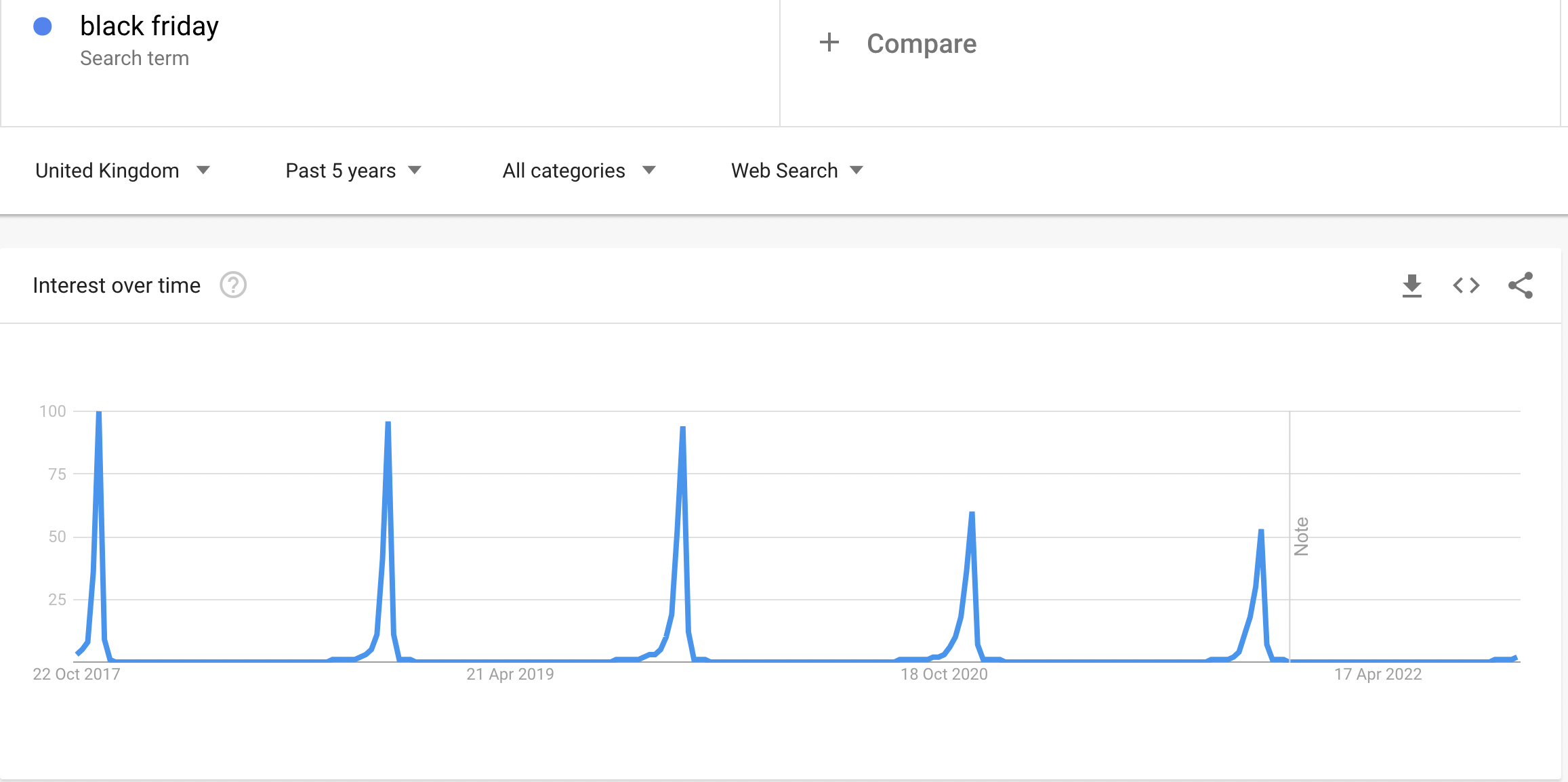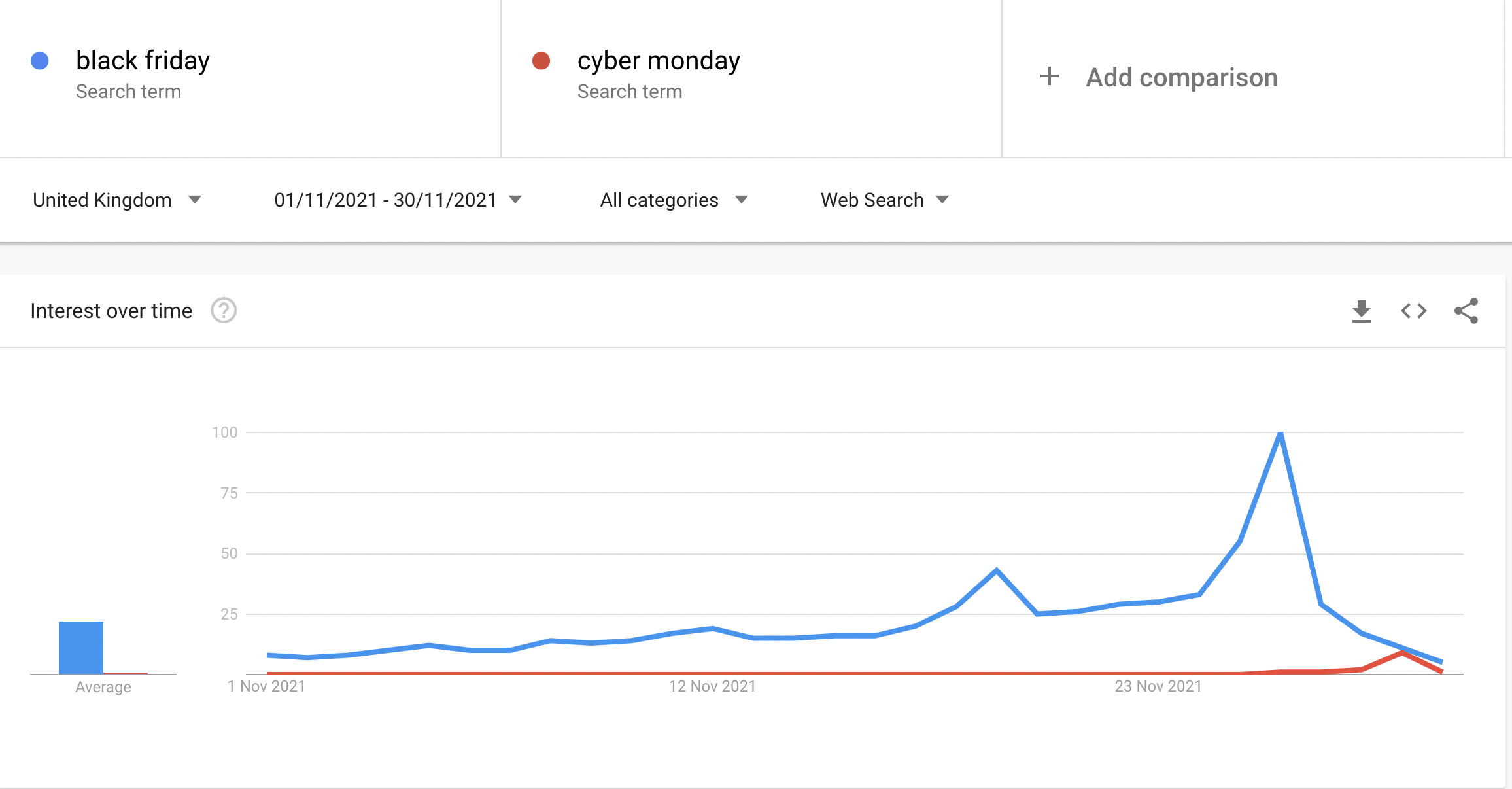It was in a recent Power Hour with a prospective eCommerce client, getting into the roots and weeds of Black Friday, that I thought it was time for a dedicated blog piece to get some of the points, topics and recommendations down on “paper”, as it were.
We covered some really interesting points, and one of my commitments as a PPC consultant is to continue putting out valuable content to anybody that might find it helpful and actionable. Here’s to hoping this piece does that.
2022 has been a turbulent year. In-fact, catastrophic would be a more apt adjective for it. War in Europe, ongoing cost of living crises, sky high energy bills, record levels of inflation, increases in interest rates, and whispers of a looming recession all causing havoc on daily life.
The impact on macro and microeconomics, and consumer behaviour has made it an incredibly difficult year to navigate for businesses, and all of this now rolls into Black Friday and Christmas.
Google Trends suggests that online searches for “black friday” have been steadily decreasing over the past 5 years, and that’s the feeling I get IRL too. It’s been a few years since I’ve seen a punch thrown over grabbing the last on-shelf 4K TV.
In November 2021, “black friday” searches were ~50% less popular than the same searches in 2017. But 5 years later, with online marketing now much more diverse than just search, these trends don’t seem to be quietening down the marketing noise.
 So below are some points on how you might be able to find performance amongst the noise, this Black Friday…
So below are some points on how you might be able to find performance amongst the noise, this Black Friday…
When?
An important question is when to deploy your Black Friday content and offers?
Timing trends are continuing to widen, but I don’t agree with many who believe that it’s now a month-long event. Businesses are curating this reality by running their offers earlier and for longer, but the figures in recent years show evidence that the single Friday event remains the biggest opportunity.
 Many businesses choose to stagger offers throughout the month, saving their best offers for Black Friday, and consumer spending follows suit. In 2021, UK consumers spent £9.42 billion during the Black Friday weekend.
Many businesses choose to stagger offers throughout the month, saving their best offers for Black Friday, and consumer spending follows suit. In 2021, UK consumers spent £9.42 billion during the Black Friday weekend.
If resources are limited, I would still focus efforts on increased activity around the main event, rather than limited month-long exposure.
No Records This Year
With the economic back drop already covered above, I think it’s fair to assume no records will be broken for Black Friday 2022. Record inflation levels might mean “false” headlines are written around record spending, but in terms of interest and overall sales, I would expect this to be the worst year seen in recent times.
With this in mind, businesses should feel relaxed and less pressured to “opt in” to Black Friday, or at least rethink expectations and targets.
On the subject of “opting in”, one of my clients actively “opts out” of all involvement in Black Friday, instead giving his staff a day off to “opt outside”. Despite this stance, the business has maintained YoY growth every November since the decision. Interesting.
Businesses feeling the pinch must also remember to leverage “free” (nothing’s free), less costly channels. Social media, email marketing, content and a focus on UX and CRO. You don’t have to throw thousands at campaigns to reach an engaged audience and prospective customers. (This advice coming from a Google Ads consultant 🧐).
Real Value & Transparency
Consumers with less disposable income will be placing an even greater importance on value, particularly if they’re investing in a luxury item.
A slowdown in discretionary spending means that products and offers won’t “sell themselves” like they might have in years past. Businesses will have to do a better job of instilling trust, social proofing, proving quality, showcasing reviews, and most importantly delivering real value.
No artificial offers, no price hikes prior to an offer and no false claims about “best ever” prices. Transparency and trust.
According to a survey of 1,000 shoppers in the U.K., 62% said they didn’t think that Black Friday prices were any better than the rest of the year.
Sustainability
IMO sustainable and ethically minded businesses have the best runways for growth over the next 10 years.
With increased spotlight and pressure on businesses to be climate conscious in their operations, those acting in this way will already be in favour, as customers seek to spend with purpose driven companies.
Consumers are becoming more aware of who they spend their money with, and the impact their purchases have on the environment. Growing slow-fashion apps like Depop, and initiatives like Patagonia’s free repair service are just a couple of examples of shifting fashion trends.
There is no doubt that large fast-fashion brands still have the pull in 2022, but mounting negative press and a climate-conscious Gen Z will see the tides turn.
Data
It shouldn’t take a blog post about Black Friday in 2022 to reaffirm how important data is to your ongoing business health. Accurate and diverse data should be the foundation for which all decision-making is based.
Brands and businesses doing the best job of collecting, processing, analysing and actioning data findings, will always be the best placed to succeed. Not just during key retail periods, but throughout the calendar year.
You should know your target audience are who your customers are. Where your customers are and how they find you and your products. How and when they buy, and common paths to purchase.
Look back at historical Black Friday data trends if you have that accurately available, but also remember that consumer trends shift quickly, most recently at the drop of a government announcement – there is a need to factor in real time data and present environment.